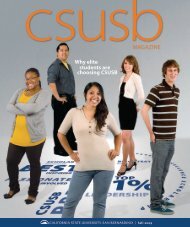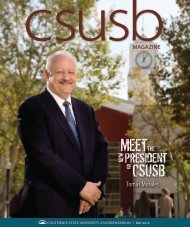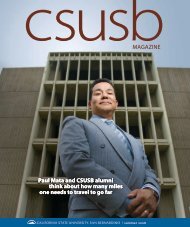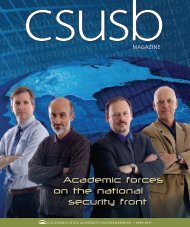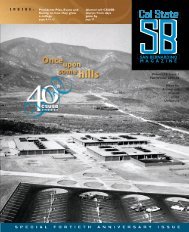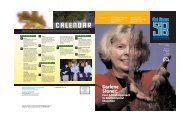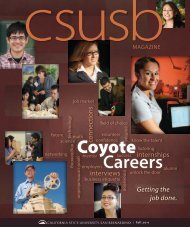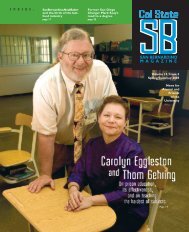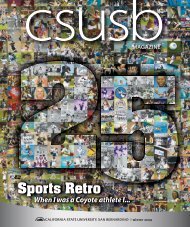Insights into the Ancient, the Contemporary Insights into the Ancient ...
Insights into the Ancient, the Contemporary Insights into the Ancient ...
Insights into the Ancient, the Contemporary Insights into the Ancient ...
Create successful ePaper yourself
Turn your PDF publications into a flip-book with our unique Google optimized e-Paper software.
Child of Egypt<br />
Benson Harer at “Secrets of <strong>the</strong> Dead,” <strong>the</strong> Robert V. Fullerton Art Museum’s 10th<br />
anniversary event held last fall<br />
Even as a child, ancient Egypt<br />
intrigued W. Benson Harer<br />
Jr. The “Gift of <strong>the</strong> Nile” would<br />
later soo<strong>the</strong> him as he completed<br />
his medical residency at<br />
<strong>the</strong> Hospital of <strong>the</strong> University<br />
of Pennsylvania in Philadelphia.<br />
When Harer needed a break<br />
from <strong>the</strong> hospital’s grueling pace,<br />
he walked <strong>the</strong> hallways of <strong>the</strong><br />
university museum instead, and<br />
gazed <strong>into</strong> <strong>the</strong> faces of gods and<br />
mortals created thousands of<br />
years ago by Egyptian artists.<br />
In <strong>the</strong> hospital Harer focused<br />
on bringing life <strong>into</strong> <strong>the</strong> world. In<br />
<strong>the</strong> museum he relaxed among<br />
<strong>the</strong> dead, among <strong>the</strong> artifacts of<br />
an ancient people who dwelled<br />
on death and <strong>the</strong> afterlife.<br />
The pull of Egypt never<br />
released its hold even as Harer<br />
and his wife, Pamela, left <strong>the</strong><br />
East Coast for San Bernardino.<br />
Benson Harer loved his work in<br />
obstetrics and gynecology, but he<br />
remained fascinated with Egypt. In<br />
1974 and 1978, he took tours to<br />
Egypt. He has since made some 30<br />
trips, all of <strong>the</strong>m with expeditions.<br />
Harer’s medical reputation already<br />
had been cemented. Before<br />
he retired, he served as presi-<br />
dent of <strong>the</strong> American College of<br />
Obstetricians and Gynecologists.<br />
In <strong>the</strong> meantime, over <strong>the</strong> years,<br />
his reputation as a scholar in<br />
Egyptology grew. He moonlighted<br />
as an adjunct professor in Egyptology<br />
at Cal State San Bernardino.<br />
In 2001, he received <strong>the</strong> first<br />
honorary Doctor of Humane Letters<br />
awarded by <strong>the</strong> university.<br />
His research paid off for<br />
CSUSB in o<strong>the</strong>r ways, too. Harer<br />
managed to piece toge<strong>the</strong>r an<br />
Egyptian collection that originated<br />
with Anthony Drexel Jr.,<br />
son of <strong>the</strong> 19th-century banker<br />
from Philadelphia credited<br />
with establishing Wall Street.<br />
The senior Drexel mentored<br />
financier J.P. Morgan and established<br />
an institution of higher<br />
learning for children of working<br />
class parents, what is now<br />
<strong>the</strong> Drexel University, known<br />
for its engineering program.<br />
Drexel Jr. pulled toge<strong>the</strong>r<br />
a collection of ancient Egyptian<br />
pieces that he donated to <strong>the</strong>n-<br />
Drexel Institute of Art, Science<br />
and Industry in 1895. The university<br />
sold <strong>the</strong> collection to<br />
<strong>the</strong> newly opened Minneapolis<br />
Institute of Arts several years<br />
later. In <strong>the</strong> 1950s, <strong>the</strong> Institute<br />
of Arts sold much of <strong>the</strong><br />
Drexel collection piecemeal to<br />
various dealers throughout <strong>the</strong><br />
United States and Europe.<br />
Harer, intent upon restoring<br />
<strong>the</strong> original Drexel collection,<br />
combed <strong>the</strong> Drexel University<br />
and Minneapolis Institute of Arts<br />
archives, researching <strong>the</strong> collection<br />
and its whereabouts.<br />
“I tracked down a lot of those<br />
pieces that had been scattered<br />
around,” he said. He purchased<br />
<strong>the</strong> items, and many of his purchases<br />
are now on display in <strong>the</strong><br />
Fullerton Art Museum on campus.<br />
Naturally, Harer’s passion for<br />
<strong>the</strong> ancient Egyptian world and<br />
for delivering new babies <strong>into</strong><br />
<strong>the</strong> world would merge. He has<br />
lectured on medical issues of <strong>the</strong><br />
ancient Egyptians. His collection<br />
includes many representations<br />
of Bes, <strong>the</strong> Egyptian god who<br />
protected pregnant women and<br />
<strong>the</strong>ir babies from evil spirits bent<br />
on killing <strong>the</strong>m. One sculpture<br />
shows a mo<strong>the</strong>r on a bed nursing<br />
her baby. The piece “reflects<br />
a universal bond of mo<strong>the</strong>r and<br />
child,” Harer noted. A favorite<br />
group of items, and a favorite<br />
of Fullerton museumgoers,<br />
are <strong>the</strong> four<br />
canopic jars created<br />
to hold a body’s organs<br />
removed during <strong>the</strong><br />
mummification process.<br />
Surgery in ancient<br />
Egypt, said Harer,<br />
was very crude,<br />
amounting to nothing<br />
more than <strong>the</strong><br />
draining of abscesses,<br />
hematomas or<br />
boils. “Nothing that<br />
we would associate<br />
with repair.” But <strong>the</strong>n,<br />
he added, nothing<br />
much changed over<br />
<strong>the</strong> next 2,500 years.<br />
“In fact, all medicine<br />
was very crude<br />
Osiris, painted<br />
gesso on wood,<br />
third intermediate<br />
period, 1069-664<br />
B.C., H: 28 in<br />
until <strong>the</strong> last 60 or 70 years.”<br />
Obstetrics changed dramatically<br />
after World War I, when<br />
<strong>the</strong> scientific era really began. It<br />
wasn’t until <strong>the</strong> end of <strong>the</strong> 19th<br />
century that doctors universally<br />
accepted <strong>the</strong> idea that germs<br />
caused disease and <strong>the</strong>y needed<br />
to wash <strong>the</strong>ir hands before surgery.<br />
Physicians didn’t even have<br />
anes<strong>the</strong>sia until <strong>the</strong> end of <strong>the</strong><br />
19th century. Antibiotics didn’t<br />
arrive on <strong>the</strong> scene until World<br />
War II.<br />
One in every five or six deaths<br />
in women was related to childbirth<br />
in ancient Egypt, said Harer.<br />
That trend, “inconceivable for us<br />
today,” remained fairly constant<br />
<strong>into</strong> <strong>the</strong> beginning of <strong>the</strong> 20th<br />
century. Infection, toxemia and<br />
hemorrhaging were <strong>the</strong> most<br />
common causes of death among<br />
Egyptian women. All are possible<br />
complications in today’s pregnant<br />
women, but conditions that,<br />
with proper prenatal care, do<br />
not usually lead to <strong>the</strong>ir death.<br />
Men only fared a bit better<br />
than <strong>the</strong>ir wives, living three or<br />
four years longer on <strong>the</strong> average.<br />
They fell victim to trauma,<br />
heart trouble and, most commonly,<br />
infections. But cancer<br />
and diseases of old age seen<br />
today, Harer said, were rare.<br />
The ancient people knew<br />
<strong>the</strong>ir time was limited and <strong>the</strong>y<br />
made intricate plans to survive<br />
in <strong>the</strong> afterlife. The Fullerton<br />
Art Museum pieces show<br />
how <strong>the</strong>y planned to feed<br />
<strong>the</strong>mselves and <strong>the</strong> gods<br />
that eased <strong>the</strong>ir cross over<br />
<strong>into</strong> death, and how <strong>the</strong><br />
living immortalized <strong>the</strong>ir<br />
loved ones’ likenesses on<br />
coffin lids and in stone. They<br />
created amulets to ward off<br />
evil. Toge<strong>the</strong>r <strong>the</strong> pieces tell<br />
a story of humanity. “They all<br />
sort of reflect a lot of people’s<br />
hopes to live on, and to live<br />
healthy lives,” Harer said.<br />
15<br />
Spring/Summer CSUSB



